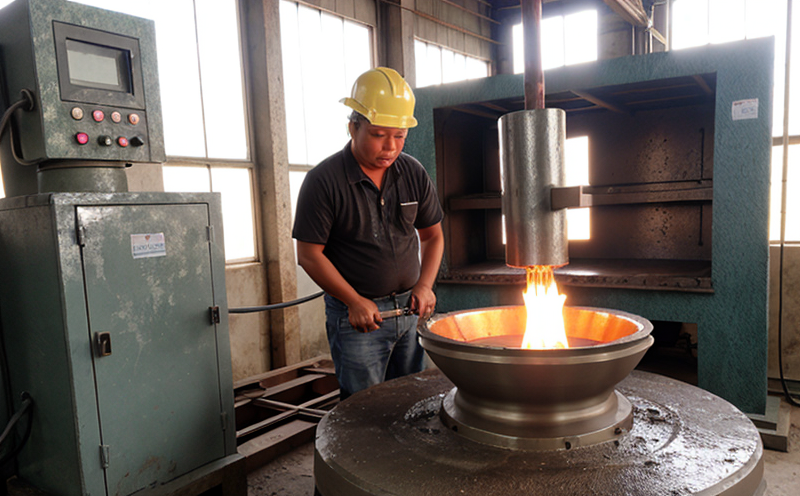ISO 8079 Porosity Testing of Cast Components
The ISO 8079 standard is a cornerstone in the evaluation and quality assurance of cast components used across various industrial sectors. This testing method specifically targets the detection and quantification of porosity within castings, which can significantly impact their structural integrity and performance. Porosity refers to the presence of voids or spaces within the casting material that may compromise its mechanical properties.
The primary objective of ISO 8079 is to provide a standardized approach for assessing the internal quality of cast iron and steel components by detecting porosity through non-destructive testing (NDT) techniques. This service ensures compliance with international standards, thereby enhancing trust in products used across industries ranging from automotive and aerospace to construction and manufacturing.
Before delving into the technical aspects, it's important to understand that porosity can arise due to several factors during the casting process, including inadequate filling of the mold, improper cooling rates, or contamination. Detecting these issues early on through ISO 8079 testing helps manufacturers identify potential defects and take corrective actions.
The process typically involves using radiographic methods (X-ray or gamma ray), which provide a visual representation of internal flaws within the casting. This allows for precise measurement and documentation, ensuring that any porosity is quantified accurately according to industry benchmarks. The test results play a crucial role in quality control processes, helping manufacturers maintain consistent product quality.
For industrial applications, especially those involving critical components where reliability is paramount, such as engine blocks or exhaust systems, ISO 8079 testing becomes indispensable. By identifying and addressing porosity issues early, industries can prevent costly failures later down the line, ensuring longevity and performance of their products.
In summary, ISO 8079 porosity testing serves multiple purposes: it ensures adherence to international standards, improves product reliability, minimizes risks associated with component failure, and fosters trust among end-users. As part of a robust quality management system, this test is an essential tool for industries reliant on cast components.
Why It Matters
The importance of ISO 8079 porosity testing cannot be overstated, particularly in sectors where the integrity and performance of cast components are critical. Porosity can lead to reduced strength and increased susceptibility to corrosion or fatigue failure, which can have severe consequences depending on the application.
- Enhanced Safety: In high-risk environments such as aviation or automotive manufacturing, ensuring that all parts meet stringent quality standards is non-negotiable. Detecting porosity early through ISO 8079 testing helps prevent catastrophic failures that could endanger lives and cause significant damage.
- Economic Benefits: By identifying defects before production, manufacturers can reduce waste, minimize rework costs, and improve overall efficiency. This not only cuts down on expenses but also contributes to a more sustainable manufacturing process.
- Regulatory Compliance: Many industries operate under strict regulatory frameworks that mandate adherence to specific quality standards. ISO 8079 provides a harmonized approach to compliance, ensuring that products meet global requirements and gain international acceptance.
- Customer Trust: Providing customers with confidence in the reliability of purchased components is crucial for business success. ISO 8079 testing builds this trust by demonstrating commitment to quality and safety standards.
In conclusion, implementing ISO 8079 porosity testing is not just about meeting technical specifications; it's about safeguarding lives, enhancing operational efficiency, and establishing credibility in the marketplace.
Quality and Reliability Assurance
- Non-Destructive Testing (NDT): ISO 8079 employs NDT methods that do not harm or alter the casting during inspection. This allows for multiple inspections if necessary without compromising the integrity of the component.
- Precision Measurement: The testing process involves precise measurements to quantify the extent and location of porosity, providing detailed reports that can guide further actions.
- Standardized Reporting: All results are documented according to ISO 8079 guidelines, ensuring consistency across different labs and facilities. This facilitates easier comparison between test results and established benchmarks.
The combination of these elements ensures that cast components undergo thorough evaluation, leading to higher confidence in their reliability and safety performance.
- Consistency Across Industries: Whether it's automotive, aerospace, or construction, ISO 8079 provides a uniform approach to porosity testing. This consistency is vital for ensuring that all tested components meet the same rigorous standards, regardless of their intended application.
- Data-Driven Decision Making: Accurate and detailed reports generated from ISO 8079 testing enable informed decisions regarding component acceptance or rejection. This data-driven approach helps minimize errors and improve overall quality control processes.
By focusing on these key aspects, the service ensures that cast components not only meet but exceed industry expectations for reliability and safety.
International Acceptance and Recognition
- Global Standardization: ISO 8079 is recognized worldwide as a reliable method for porosity testing. Its widespread acceptance ensures that test results are universally understood and respected.
- Cross-Border Trade Facilitation: Compliance with this standard simplifies trade between countries, eliminating the need for additional inspections or certifications in different regions.
- Industry Best Practices: Adherence to ISO 8079 reflects a commitment to best practices that are continually updated and refined. This ensures that testing methods remain relevant and effective.
The international recognition of this standard underscores its importance not only within specific industries but across global markets, fostering collaboration and innovation.
- Competitive Edge: Companies adopting ISO 8079 demonstrate their commitment to excellence, giving them a competitive edge in the market. This can lead to increased customer satisfaction and loyalty.
- Sustainability: By ensuring that products meet stringent quality standards right from the design phase, organizations contribute positively towards sustainability goals.
Overall, ISO 8079 porosity testing is a vital component in maintaining high-quality standards across diverse industrial applications. Its global recognition and widespread adoption highlight its significance in promoting reliability and safety within manufacturing processes.





